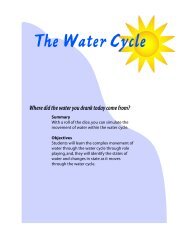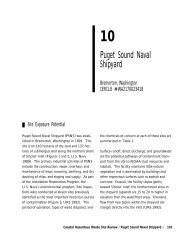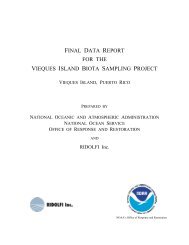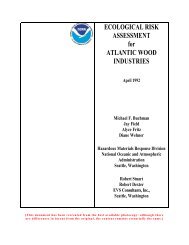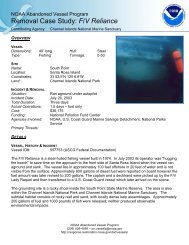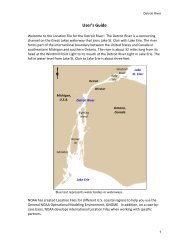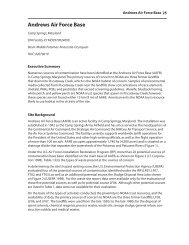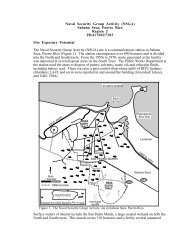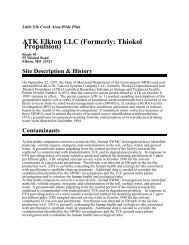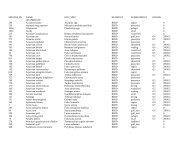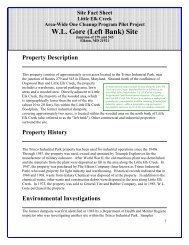Watershed Database and Mapping Projects: Hudson River (New York)
Watershed Database and Mapping Projects: Hudson River (New York)
Watershed Database and Mapping Projects: Hudson River (New York)
Create successful ePaper yourself
Turn your PDF publications into a flip-book with our unique Google optimized e-Paper software.
esource information <strong>and</strong> contaminant distributions across the<br />
watershed enhances the potential for successful restoration of wideranging<br />
populations. The <strong>Watershed</strong> <strong>Projects</strong> have benefited a variety<br />
of user groups <strong>and</strong> have enhanced cooperation <strong>and</strong> data sharing.<br />
ARD is developing the <strong>Hudson</strong> <strong>River</strong> <strong>Watershed</strong> Project, which<br />
includes the entire <strong>Hudson</strong> <strong>River</strong> Superfund site, over 200 river<br />
miles from the mouth of the river in <strong>New</strong> <strong>York</strong> Harbor to beyond<br />
<strong>Hudson</strong> Falls. Fish <strong>and</strong> sediments throughout the <strong>Hudson</strong> <strong>River</strong><br />
are contaminated with polychlorinated biphenyls (PCBs), forcing<br />
commercial <strong>and</strong> recreational fishing closures <strong>and</strong> advisories<br />
throughout the river.<br />
The project integrates sediment chemistry <strong>and</strong> tissue chemistry data<br />
from<br />
· EPA’s Superfund Reassessment Remedial Investigation;<br />
· The State of <strong>New</strong> <strong>York</strong>’s long-term monitoring of PCB <strong>and</strong> other<br />
contaminant concentrations in fish throughout the river;<br />
· General Electric’s investigations of sediment <strong>and</strong> fish;<br />
· NOAA’s studies of PCB levels in fish; <strong>and</strong><br />
· The U.S. Department of the Interior’s studies of PCB<br />
concentrations in treeswallow nestlings, eggs <strong>and</strong> prey<br />
organisms.<br />
The <strong>Hudson</strong> <strong>River</strong> <strong>Watershed</strong> Project’s objective is to provide state<br />
<strong>and</strong> federal trustees with the ability to integrate the large amount<br />
of existing point data on sediment chemistry, tissue chemistry, <strong>and</strong><br />
sediment toxicity with maps that identify key habitats, potential<br />
restoration sites, <strong>and</strong> potential point sources (including stormwater).<br />
Maps showing the distribution of Brownfield sites, l<strong>and</strong> uses,<br />
contaminant distributions, wetl<strong>and</strong>s, <strong>and</strong> other information can help<br />
focus cooperative restoration planning <strong>and</strong> improve decision-making<br />
processes.<br />
Analytical tools such as database queries <strong>and</strong> import/export scripts<br />
developed for one project can be applied to all projects because of<br />
the common database <strong>and</strong> GIS project structure. Query Manager<br />
can be used to select <strong>and</strong> export data to any program that supports<br />
st<strong>and</strong>ard spreadsheet, database, or tab-delimited text files. Scripts<br />
have been developed for seamless import of data from Query<br />
Manager to ArcView ® GIS to enhance <strong>and</strong> simplify further data<br />
analysis <strong>and</strong> presentation.<br />
The <strong>Watershed</strong> <strong>Projects</strong> run on st<strong>and</strong>ard desktop Microsoft<br />
Windows ® -based personal computers. The database <strong>and</strong> mapping<br />
application, Query Manager is an easy-to-use, interactive system<br />
that allows you to query the database <strong>and</strong> rapidly display the results<br />
on a map in MARPLOT ® or deliver the data in the appropriate form<br />
to the watershed ArcView GIS project. In addition, both st<strong>and</strong>ard<br />
<strong>and</strong> customized base maps are developed in ArcView to support all<br />
<strong>Watershed</strong> <strong>Projects</strong>. St<strong>and</strong>ard layers include wetl<strong>and</strong>s, Superfund<br />
sites, <strong>and</strong> regulated industrial facilities <strong>and</strong> NOAA digital navigation<br />
charts. Custom imagery <strong>and</strong> other spatial data layers also are<br />
routinely used with data from the Query Manager database.<br />
ARD’s <strong>Watershed</strong> <strong>Projects</strong> are proving useful throughout the<br />
Superfund remedial decision-making process, from identifying<br />
locations for the collection of additional samples to providing the<br />
historical context for interpreting data, to identifying areas for<br />
restoration. This versatile tool improves NOAA’s ability to protect<br />
<strong>and</strong> restore the biodiversity of watersheds that contribute to healthy<br />
coastal habitats, <strong>and</strong> has the potential to help address other<br />
important environmental issues.<br />
For additional information:<br />
Alyce Fritz (206) 526-6305<br />
Jay Field (206) 526-6404<br />
http://response.restoration.noaa.gov<br />
NOAA’s Office of Response & Restoration—Protecting our Coastal Environment<br />
For further information about NOAA’s Office of Response <strong>and</strong> Restoration,<br />
please visit our Web site at<br />
http://response.restoration.noaa.gov or call (301) 713-2989.<br />
U.S. Department of Commerce • National Oceanic <strong>and</strong> Atmospheric Administration<br />
March 2007



